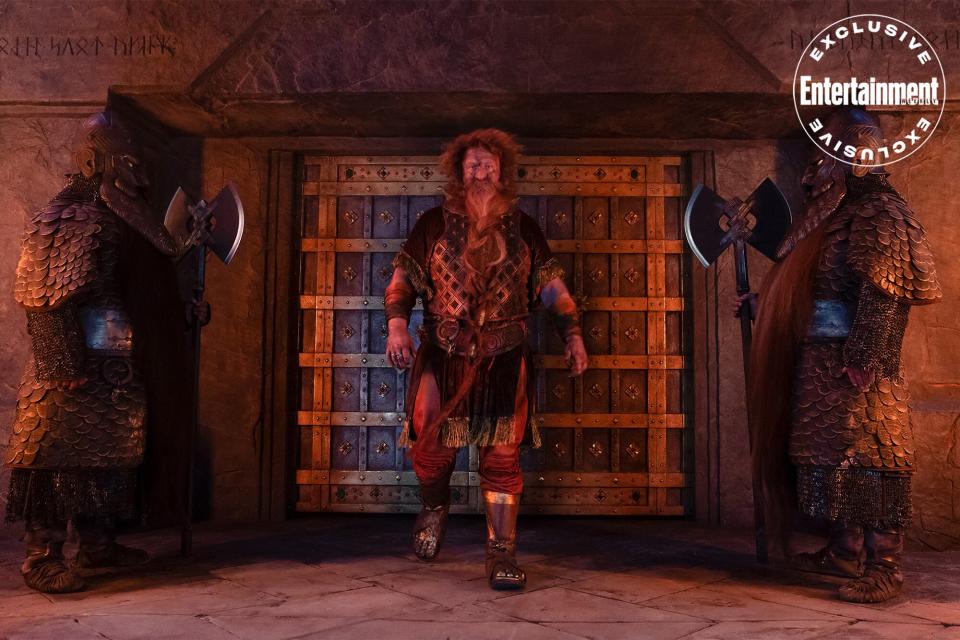How The Lord of the Rings: The Rings of Power crafted a new (old) Middle-earth
- Oops!Something went wrong.Please try again later.
The Lord of the Rings may be packed with cozy hobbit holes, soaring towers, and majestic stone cities, but the splendor of J.R.R. Tolkien's Second Age makes that era look downright drab. The Rings of Power, Amazon Prime Video's upcoming TV epic, is set centuries before Frodo trekked to Mordor, and the landscape of Middle-earth looks decidedly different. The elves have founded the regal coastal realm of Lindon. The dwarvish stronghold of Khazad-dûm is thriving. Even mankind is in an unprecedented golden age, and the opulent island of Númenor boasts great cities and harbors.
For Rings of Power production designer Ramsey Avery (known for his work on films like 10 Cloverfield Lane and Guardians of the Galaxy Vol. 2), the toughest task was crafting a Middle-earth that felt both familiar and fresh. "It's all about how this world is vibrant and rich and golden," he tells EW, "as opposed to what we see in the movies, which is the Third Age, when everything is on its decline, and it's fading."
Because The Rings of Power follows dozens of characters across countless locations, Avery and his fellow department heads had to establish a unique visual style for each. The elves, for example, have a lifelong love of nature, so the architecture of Lindon is almost Gothic in style, filled with tall, tree-like columns and arboreal details. For Khazad-dûm, Avery wanted to depict the legendary mine as it was before the dwarves "got greedy" and the Balrog moved in. So, instead of using harsh lines and gargantuan statues, this early version is far less severe (but no less grand). "We thought, 'Well, let's go back to the true nature of the dwarves and how they are of stone and of flame,' " Avery says. "Their architecture, and even their clothing, is much more sensible. There's a sensitivity toward the stone, rather than forcing their will on the stone."

Ben Rothstein / Prime Video Owain Arthur as Prince Durin IV in 'The Lord of the Rings: The Rings of Power'
Even the nomadic harfoots have their own distinct look. These pint-sized travelers are years away from settling in the Shire and becoming the homebody hobbits we know and love, but Avery wanted them to still feel familiar to anyone who knows Frodo and friends. He notes similarities throughout, like how the harfoots' large, circular wagon wheels echo those iconic round hobbit doors.
One of the production designer's biggest challenges was bringing the great island of Númenor to life. Tolkien's grand, Atlantis-like kingdom has never before been depicted on screen, and Avery found inspiration in great civilizations of the past, designing the city's looming marble structures to feel almost Grecian or Venetian.
"It's this powerful country that has this great strength in sailing and great value in the water, so that's why blue is everywhere," he adds. "We've got a zillion different shades of blue."
Despite juggling elvish forests, dwarven caves, and seaside cities, Avery vowed to keep even the most fantastic locations grounded, building as many practical sets as possible. "We wanted it to feel real and honest and as present as we possibly could," he explains. "We wanted to make sure that the actors had a world that felt inhabitable by them." For the cast and crew, that meant stepping into an environment that felt straight from Tolkien's pages. As co-showrunner JD Payne puts it: "It was like going to Middle-earth every day for work."
The Lord of the Rings: The Rings of Power will debut on Prime Video Sept. 2.
A version of this story appears in Entertainment Weekly's Comic-Con print issue, available exclusively in person at San Diego Comic-Con. Stay tuned for more exclusive details about The Lord of the Rings: The Rings of Power, as well as new images and interviews previewing some of the most anticipated movies and TV shows at SDCC.
Related content:

